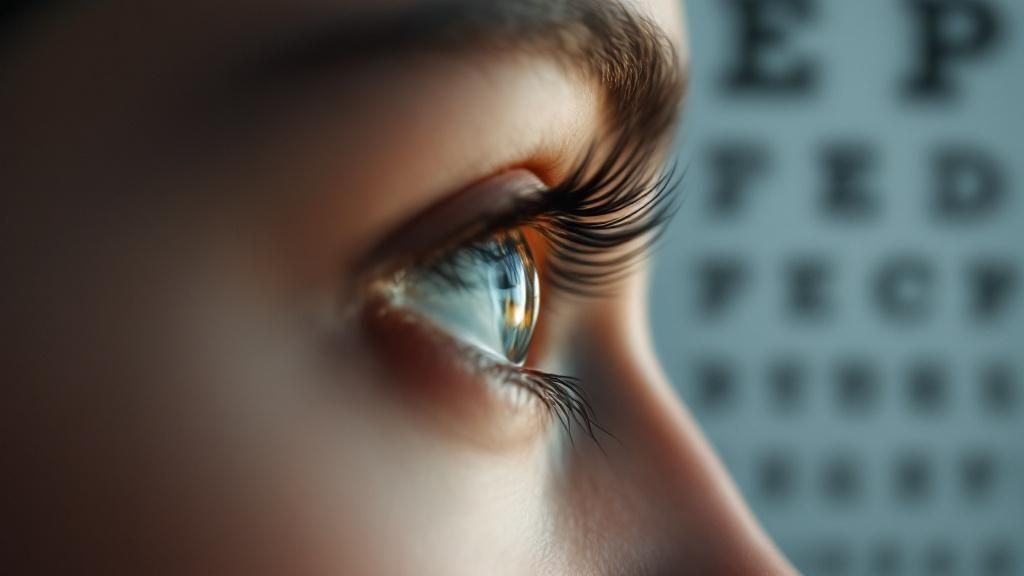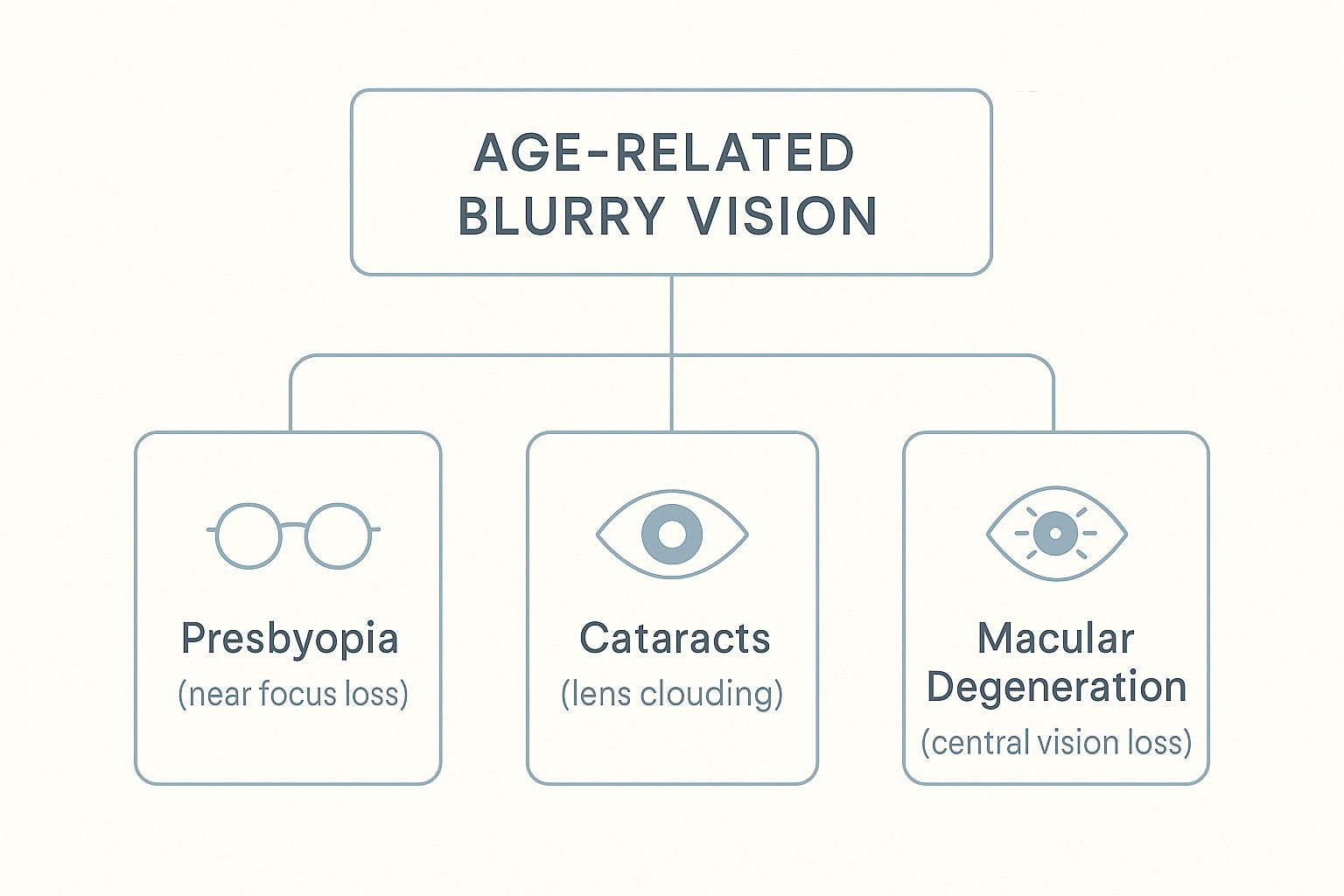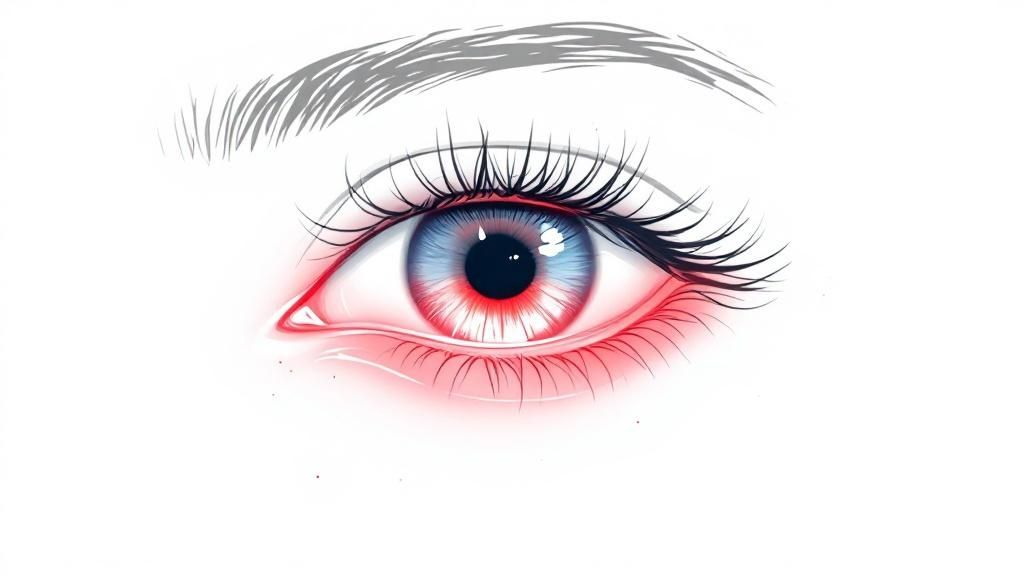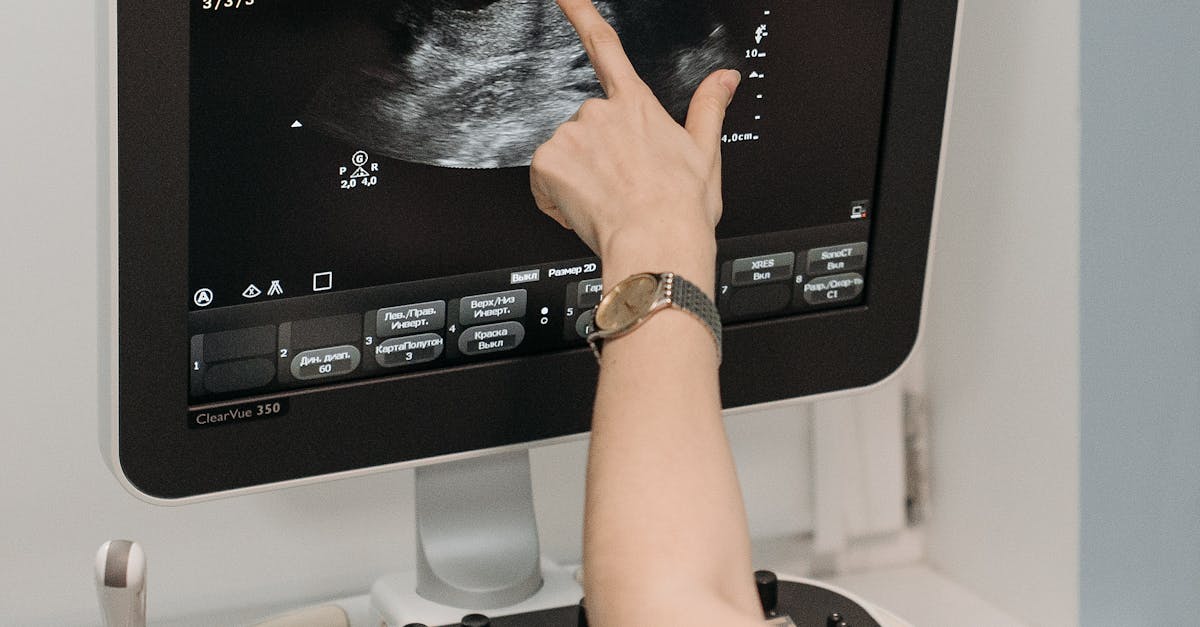If you’ve ever found yourself wondering, “what causes blurry vision,” you’re not alone. The answer is often simpler than you might think. For many people in Glendale Heights, the culprit is a refractive error—like nearsightedness or farsightedness—which means your eye just isn’t focusing light correctly. Other everyday causes can be as simple as digital eye strain or dry eyes.
Why Is Your Vision Blurry? Answering the Core Question

alt=”A person experiencing blurry vision in Glendale Heights”
Blurry vision is one of the top reasons people in Glendale Heights and the surrounding communities schedule an eye exam. It can feel unsettling when the world loses its sharp edges, but figuring out the root cause is the first step toward getting back to clear sight.
Think of your eye as a sophisticated camera trying to snap a crisp, high-definition photo. To get that perfect shot, the camera’s lens has to focus light precisely onto the sensor at the back. When everything is working just right, you see the world with incredible clarity.
But what happens if the lens isn’t focused perfectly? The image comes out fuzzy and indistinct. This is exactly what happens with blurry vision. A number of things can throw off this delicate focusing process in your eyes.
The Most Common Culprits
For many of our patients, from Carol Stream to Bloomingdale, the source of their blurry vision is a simple refractive error. These are common conditions where the unique shape of your eye keeps light from bending properly.
In fact, uncorrected refractive errors are a leading cause of vision impairment for millions across the globe. It’s important to know that these aren’t diseases; they’re focusing problems that are usually straightforward to correct. You can learn more about the worldwide scope of these issues in this detailed study on vision impairment.
The key takeaway is that for most people, blurry vision isn’t a sign of a serious problem. It’s simply an indication that your eyes need a little help focusing. A professional diagnosis is the only way to know for sure.
The main types of refractive errors we see are:
- Nearsightedness (Myopia): This is when you can see things up close just fine, but objects in the distance look fuzzy.
- Farsightedness (Hyperopia): Here, close-up objects are blurry, while things farther away might be clearer.
- Astigmatism: Vision is blurry at all distances because of an irregular curve in your cornea, much like looking through a warped window.
To help you get a quick overview, here’s a simple breakdown of these common issues.
Common Causes of Blurry Vision at a Glance
| Cause | What It Is | Common Symptom |
|---|---|---|
| Nearsightedness | Difficulty seeing distant objects clearly. | Squinting to see road signs or the TV. |
| Farsightedness | Difficulty seeing close-up objects clearly. | Eye strain or headaches after reading. |
| Astigmatism | Vision is blurry at all distances due to an irregular eye shape. | General fuzziness or distorted vision. |
| Dry Eye | Lack of sufficient tears to lubricate the eye’s surface. | Blurriness that comes and goes, especially with blinking. |
This table covers the most frequent and treatable causes we encounter.
Of course, refractive errors aren’t the only story. Temporary issues like digital eye strain from spending hours in front of a screen or even just dry eyes can disrupt the smooth surface of your eye and impact clarity. At iDoctor, our first goal is to pinpoint the exact cause with a detailed eye exams in Glendale Heights, giving you both answers and a clear path forward.
Understanding How Your Eyes Focus
Think of your eye like a high-tech camera. For you to see a crisp, clear picture, the cornea and lens at the front of your eye have to work together perfectly. Their job is to bend incoming light so it lands precisely on the retina, the light-sensitive “film” at the back of your eye.
When everything lines up just right, your vision is sharp. But if the shape of your eye is even slightly off, the light doesn’t focus correctly, causing what’s known as a refractive error. This is, by far, the most common reason for blurry vision.
Refractive errors aren’t diseases; they’re simply a mismatch between your eye’s shape and its focusing power. For many of our patients from Lombard and Glen Ellyn, realizing this helps take the mystery out of their vision problems.
Common Refractive Errors Explained
At iDoctor, we see three main types of refractive errors every day. Each one bends light a little differently, affecting your vision in its own unique way.
- Nearsightedness (Myopia): Can you see your phone screen perfectly but struggle to read road signs? That’s myopia. It happens when your eye focuses light in front of the retina instead of on it, making distant objects look fuzzy. It’s often the reason people get their very first pair of glasses.
- Farsightedness (Hyperopia): This is the opposite of myopia. You might see distant objects clearly, but your eyes strain to focus on anything up close, like a book or a menu. This constant effort can cause headaches and blurry near vision because the light is trying to focus behind the retina.
- Astigmatism: If your vision is a bit blurry at all distances, astigmatism could be the culprit. It means your cornea or lens is shaped more like a football than a perfect sphere. This irregular curve scatters light instead of focusing it to a single point, distorting your vision like looking through a funhouse mirror.
How Aging Affects Your Focus
Getting older brings natural changes to our bodies, and our eyes are no exception. The most common age-related issue we see is presbyopia. This isn’t a refractive error, but rather a natural stiffening of the eye’s lens.
Presbyopia usually starts around age 40, making it harder and harder to focus on things up close. Many of our patients from Villa Park and Roselle come to us when they realize they need to hold their phone at arm’s length just to read a text.
The right glasses or contacts are the key to managing these conditions. If you’re looking for guidance, check out our post on how to choose the perfect eyeglasses for your face shape and lifestyle.
The image below highlights some of the most common causes of age-related blurry vision.

alt=”Illustration showing age-related eye conditions like presbyopia and cataracts that cause blurry vision”
As you can see, while presbyopia affects your near vision, other conditions like cataracts and macular degeneration can also develop as we age. Knowing the difference is the first step toward getting the right diagnosis and restoring clear sight.
When Blurry Vision Signals a Deeper Issue

alt=”An optometrist examines a patient’s eyes for serious causes of blurry vision”
While many causes of blurry vision are simple fixes, sometimes your eyes are sending a serious warning sign. It’s one thing if your vision has been getting fuzzy over the course of years, but it’s another thing entirely if it happens suddenly. That’s when you need to pay close attention.
For our patients across Addison and Villa Park, understanding the difference is key to protecting their sight for the long haul. Think of it like this: a slow, gradual blur is like a whisper, but a sudden change, especially with pain or other symptoms, is your body sounding an alarm.
Let’s walk through a few serious eye conditions where blurry vision is a major red flag. Catching them early can make all the difference.
Cataracts: The Slow Frosting of Your Vision
One of the most common reasons for progressively blurry vision, especially as we get older, is cataracts. The best way to picture it is to imagine you’re looking through a window that’s slowly getting frosted over. That’s what developing a cataract feels like.
It happens when the eye’s natural lens, which is supposed to be crystal clear, starts to get cloudy. This cloudiness blocks light from reaching the back of your eye correctly, making your vision seem dim, hazy, or blurred. It’s a slow process, so you might not even realize it’s happening at first. In the United States, cataracts are a leading cause of vision loss in adults over 40.
Glaucoma: The Silent Thief of Sight
Glaucoma is a different beast altogether. It’s a group of diseases that directly damage the optic nerve—the critical cable connecting your eye to your brain. Most often, this damage comes from high pressure inside the eye, known as intraocular pressure.
Glaucoma has a frightening nickname: the “silent thief of sight.” That’s because it rarely has symptoms in the early stages. The first thing to go is your peripheral (side) vision, so you might not notice a problem until permanent, significant damage is already done.
This is exactly why we stress the importance of regular eye exams, especially for our patients in communities like Lombard. We can spot the subtle signs of high eye pressure or optic nerve changes long before you’d ever notice them on your own.
Conditions Linked to Your Overall Health
Your eyes are a window to your overall health, and sometimes, blurry vision is a symptom of a much larger medical issue happening elsewhere in your body.
- Diabetic Retinopathy: For anyone with diabetes, uncontrolled high blood sugar can wreak havoc on the tiny, delicate blood vessels in the retina. This is called diabetic retinopathy, and it’s a primary cause of blindness in American adults. Early on, it might just cause some blurry vision, floaters, or dark patches in your sight.
- Age-Related Macular Degeneration (AMD): This condition is a leading cause of vision loss for people over 50. AMD attacks the macula, the part of your retina you need for sharp, straight-ahead vision. It creates blurriness or a dark spot right in the center of your view, making it hard to read, drive, or even see the faces of people you love.
With these conditions, early detection is your absolute best defense. We dive deeper into this topic in our article on the many reasons for blurry vision. A comprehensive eye exam is the only reliable way to catch these problems before they steal your sight for good.
How Your Lifestyle Can Affect Your Vision

alt=”A person at a computer suffering from digital eye strain, a cause of blurry vision”
While the shape of your eye or an underlying medical issue can certainly cause blurry vision, sometimes the culprit is hiding in plain sight—it’s woven right into your daily habits. For families and professionals here in Roselle and Itasca, our eyes are putting in more overtime than ever before.
Often, what seems like a serious vision problem is actually your eyes’ temporary reaction to your environment. These factors can trigger discomfort and intermittent blurriness that, while not typically dangerous, can really get in the way of your day.
The Impact of Digital Eye Strain
One of the most frequent offenders we see is Digital Eye Strain (DES), which you might also hear called computer vision syndrome. Just stop and think about how many hours a day you spend looking at a screen—your computer, tablet, or smartphone.
When you’re locked into a digital device, your blink rate can plummet by as much as 50%. Blinking is your body’s natural squeegee, spreading tears across the eye to keep it moist and clear. Without enough blinking, that tear film evaporates, leaving your eyes feeling dry, tired, and, you guessed it, blurry.
This temporary blur is your eyes screaming for a break. The non-stop focusing required by screens fatigues your eye muscles, just like your legs would feel after a long run.
A great way to fight this is to use the 20-20-20 rule. It’s simple: for every 20 minutes of screen time, take a 20-second break to look at something at least 20 feet away. This simple exercise gives your eye muscles a chance to relax and reset. For a more detailed look, check out our guide on effective treatments for digital eye strain.
Other Lifestyle Factors That Affect Clarity
Screen time isn’t the only thing to watch out for. Several other common habits and conditions can lead to temporarily fuzzy vision. Knowing what they are can help you connect the dots and find relief.
Here are a few other things to keep in mind:
- Dry Eye Syndrome: This happens when your eyes aren’t producing enough tears, or the tears they do make aren’t the right quality. It can be triggered by aging, certain medications, or even just a dry environment, causing a sandy, gritty feeling and fluctuating blurriness.
- Seasonal Allergies: When allergy season sweeps through communities like Hanover Park, it brings more than just sneezing. Many people suffer from itchy, watery, and swollen eyes, and all that inflammation can easily interfere with clear vision.
- Certain Medications: A surprising number of common medications—including some antihistamines, decongestants, and antidepressants—list dry eyes and blurred vision as side effects because they can reduce your natural tear production.
- Lack of Sleep: Your eyes need rest to recover, just like the rest of your body. When you don’t get enough quality sleep, you might experience eye strain, annoying twitches, and temporary blurriness.
If you think any of these lifestyle factors are behind your vision issues, the team at iDoctor is here to help. During a comprehensive exam, we’ll talk through your daily routines to pinpoint the cause and recommend the right solutions, whether it’s specialized eye drops, protective eyewear, or simple habit changes.
How We Get to the Bottom of Blurry Vision at iDoctor
When your world starts to look fuzzy, the last thing you need is a fuzzy diagnosis. Here at iDoctor, we skip the guesswork. We blend a truly personal, one-on-one approach with some seriously powerful diagnostic technology to give our patients from Wheaton and Schaumburg solid answers. You’ll leave feeling confident that we know exactly what’s causing your vision issues.
Everything starts with our 30-minute detailed eye exam in Glendale Heights. We intentionally book longer appointments because a quick, rushed exam can easily miss the subtle clues your eyes are giving us. This dedicated time allows us to really listen to what you’ve been experiencing, talk about how your lifestyle affects your vision, and run a full suite of tests without anyone watching the clock.
Using Advanced Technology to See the Full Picture
A cornerstone of our exam is our advanced retinal imaging. The best way to think of it is like having an ultra-high-definition photograph taken of the inside of your eye. This gives us a crystal-clear view of your retina, your optic nerve, and all the tiny, delicate blood vessels that are so crucial to your sight.
This incredible detail is a game-changer for two main reasons:
- Nailing Down Your Prescription: The images help us measure exactly how your eyes bend and focus light. This leads to a remarkably precise prescription for your glasses or contacts.
- Spotting Disease Before It Starts: Even more importantly, this technology lets us see the absolute earliest signs of serious conditions like glaucoma, diabetic retinopathy, and macular degeneration—often long before you’d ever notice symptoms on your own.
We’re not just fixing the blur you see today; we’re looking ahead to protect your vision for years to come. By getting this complete picture of your eye health, we can be proactive and work on preventing problems before they start.
We’ve invested in this level of technology because it gives us—and you—total peace of mind. If you’re curious to learn more about the tools we use, we dive into some of the latest breakthroughs in our article on innovations in eye exam technology. Our promise is to use the best tools out there to find the root cause of your blurry vision and get you back to seeing clearly.
Finding Your Path to Perfectly Clear Vision
Getting to the bottom of what’s causing your blurry vision is the crucial first step. But the real journey begins with finding the right solution to bring your world back into sharp focus. Here at iDoctor, we don’t believe in one-size-fits-all fixes. We develop personalized treatment paths that get to the root of the problem, giving you care that’s as unique as your own eyes.
For most of our patients, from Bloomingdale to Medinah, the fix is usually a straightforward one: correcting a refractive error like nearsightedness or farsightedness. This is where our passion for exceptional eyewear really comes into play. We’ll personally guide you through our hand-picked collections to find frames that don’t just restore your vision, but also feel like a true reflection of your style.
Eyewear and Lenses for Every Lifestyle
Your glasses should feel great to wear, period. That’s why we stock a wide array of options, from timeless Ray-Ban classics to iconic luxury brands. We’ll help you find the perfect pair of designer eyeglasses Glendale Heights, featuring sought-after names like:
- Cartier
- Tom Ford
- Gucci
- Oliver Peoples
- Prada
If you’d rather go without frames, we also offer meticulous contact lens fittings. We take the time to find the exact type and fit for your specific eyes, ensuring your vision stays clear and comfortable from morning to night.
Managing Long-Term Eye Health
When blurry vision is caused by a medical condition like cataracts or glaucoma, our approach shifts to careful management and monitoring. We’ll lay out a clear, understandable plan to protect your sight for the long haul. This often involves co-managing your care with trusted specialists and using our advanced imaging technology to track every detail of your eye health.
Think about this: a staggering 2.2 billion people around the world live with a vision impairment. What’s truly astonishing, though, is that nearly half of these cases could have been prevented or treated. The main culprits are often cataracts and simple uncorrected refractive errors, which really highlights just how critical professional eye care is. You can read more from the World Health Organization about these findings.
Making this level of expert care accessible is fundamental to what we do. We’re proud to accept all major vision insurance plans, and our team is fantastic at helping you maximize your benefits. Whether you’re dealing with a complex condition or just need a new prescription, we’re committed to helping you find your way back to perfectly clear vision. The best defense is a good offense, and regular check-ups are key. You can learn more about how often you should get an eye exam in our detailed guide.
Your Blurry Vision Questions Answered
It’s completely normal to have questions when your vision suddenly goes blurry. It can be a jarring experience, and we get it. To put your mind at ease, we’ve gathered the most common questions we hear from our patients and answered them just like we would in our office.
When should I get an eye exam for blurry vision?
If you’re dealing with blurry vision that just won’t go away, the answer is simple: schedule an eye exam now. Don’t wait for your next scheduled check-up or hope it gets better on its own. For sudden, severe blurriness, or blurriness accompanied by pain, flashes of light, or a “curtain” over your vision, seek care immediately.
Why choose iDoctor over a big chain eye care center?
It comes down to our personal, in-depth approach. At iDoctor, you’re not just a number. Our 30-minute appointments ensure we have time to listen and perform a thorough exam using high-resolution imaging. This allows for an incredibly precise diagnosis. It’s this boutique, detailed experience that makes us the best optometrist near Lombard for patients who want personalized care and access to luxury eyewear.
Do you offer Gucci glasses near me?
Yes, we do! We have a curated collection of luxury brands, including Gucci, Cartier, Tom Ford, and Prada, right here in our Glendale Heights boutique. We also carry a wide range of affordable brands like Ray-Ban and Coach. We believe great vision and great style go hand-in-hand.
You shouldn’t have to live your life through a haze. At iDoctor, we pair our deep experience and advanced diagnostic tools with genuine, personalized care to give you the clarity you need—both in your vision and in your understanding of your eye health. Whether it’s a thorough eye exam in Glendale Heights or finding the perfect pair of designer eyeglasses, we’re here to help you see your world clearly.
Ready to get started? Book your appointment today by visiting us at https://idoctoril.com.





